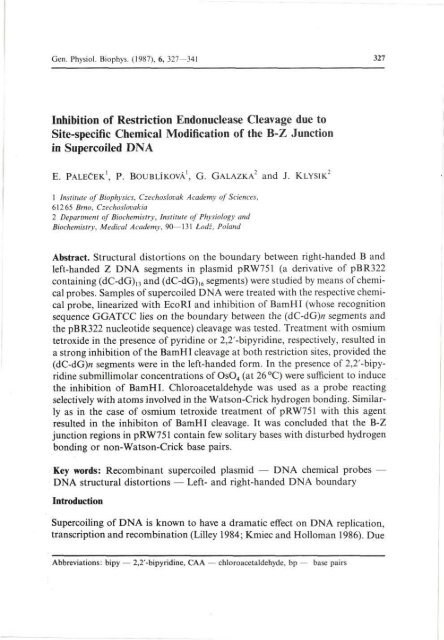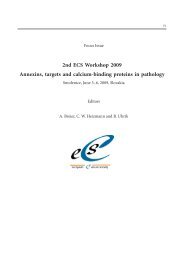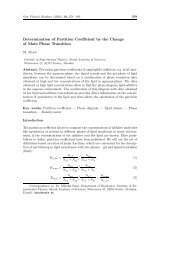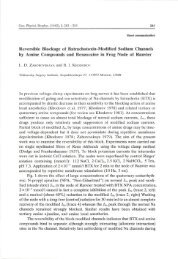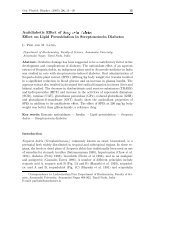Inhibition of Restriction Endonuclease Cleavage due to ... - Gpb.sav.sk
Inhibition of Restriction Endonuclease Cleavage due to ... - Gpb.sav.sk
Inhibition of Restriction Endonuclease Cleavage due to ... - Gpb.sav.sk
You also want an ePaper? Increase the reach of your titles
YUMPU automatically turns print PDFs into web optimized ePapers that Google loves.
Gen. Physiol. Biophys. (1987), 6, 327—341 327<strong>Inhibition</strong> <strong>of</strong> <strong>Restriction</strong> <strong>Endonuclease</strong> <strong>Cleavage</strong> <strong>due</strong> <strong>to</strong>Site-specific Chemical Modification <strong>of</strong> the B-Z Junctionin Supercoiled DNAE. PALEČEK 1 , P. BOUBLÍKOVÁ 1 , G. GALAZKA 2 and J. KLYSIK 21 Institute <strong>of</strong> Biophysics, Czechoslovak Academy <strong>of</strong> Sciences,61265 Brno, Czechoslovakia2 Department <strong>of</strong> Biochemistry, Institute <strong>of</strong> Physiology andBiochemistry, Medical Academy, 90—131 Lodí, PolandAbstract. Structural dis<strong>to</strong>rtions on the boundary between right-handed B andleft-handed Z DNA segments in plasmid pRW751 (a derivative <strong>of</strong> pBR322containing (dC-dG), 3and (dC-dG) 16segments) were studied by means <strong>of</strong> chemicalprobes. Samples <strong>of</strong> supercoiled DNA were treated with the respective chemicalprobe, linearized with EcoRI and inhibition <strong>of</strong> BamHI (whose recognitionsequence GGATCC lies on the boundary between the (dC-dG)n segments andthe pBR322 nucleotide sequence) cleavage was tested. Treatment with osmiumtetroxide in the presence <strong>of</strong> pyridine or 2,2'-bipyridine, respectively, resulted ina strong inhibition <strong>of</strong> the BamHI cleavage at both restriction sites, provided the(dC-dG)n segments were in the left-handed form. In the presence <strong>of</strong> 2,2'-bipyridinesubmillimolar concentrations <strong>of</strong> Os0 4(at 26 °C) were sufficient <strong>to</strong> inducethe inhibition <strong>of</strong> BamHI. Chloroacetaldehyde was used as a probe reactingselectively with a<strong>to</strong>ms involved in the Watson-Crick hydrogen bonding. Similarlyas in the case <strong>of</strong> osmium tetroxide treatment <strong>of</strong> pRW751 with this agentresulted in the inhibi<strong>to</strong>n <strong>of</strong> BamHI cleavage. It was concluded that the B-Zjunction regions in pRW751 contain few solitary bases with disturbed hydrogenbonding or non-Watson-Crick base pairs.Key words: Recombinant supercoiled plasmid — DNA chemical probes —DNA structural dis<strong>to</strong>rtions — Left- and right-handed DNA boundaryIntroductionSupercoiling <strong>of</strong> DNA is known <strong>to</strong> have a dramatic effect on DNA replication,transcription and recombination (Lilley 1984; Kmiec and Holloman 1986). DueAbbreviations: bipy — 2,2'-bipyridine, CAA — chloroacetaldehyde, bp — base pairs
328 Paleček et al.<strong>to</strong> superhelicity some structural forms <strong>of</strong> DNA are stabilized (e. g. cruciformsand left-handed Z-helices), which do not occur in non-superhelical DNA underphysiological conditions (Rich et al. 1984). These local perturbations <strong>of</strong> doublehelicalDNA which occur in regions with specific nucleotide sequences probablyplay an important role in the regulation <strong>of</strong> gene expression, and have thereforebeen studied intensively in recent years. Until recently the research on localconformational changes in superhelical DNA was mainly undertaken usingsingle-strand selective nucleases (especially nuclease SI). Their use is based onthe fact that these conformational changes usually include a portion <strong>of</strong> basesmore accessible <strong>to</strong> interaction with the environment than those contained in Bform. The interpretation <strong>of</strong> results obtained using these nucleases is made moredifficult by the fact that the mechanism <strong>of</strong> their action on DNA is not knownin detail and that the interaction <strong>of</strong> protein with DNA can induce DNAstructural changes.In studying the polymorphism <strong>of</strong> double helical DNA in the past, themethods <strong>of</strong> electrochemical analysis (Paleček 1976; Paleček 1983) have beenfound <strong>to</strong> be advantageous, though they do not allow the location <strong>of</strong> the structuralchange in the DNA molecule <strong>to</strong> be determined. Several years ago we turnedour attention <strong>to</strong> the development <strong>of</strong> chemical probes <strong>of</strong> DNA structure whichwould form electroactive markers in the polynucleotide chain detectable bymodern electrochemical analysis and which would extend significantly the methodicalreper<strong>to</strong>ire <strong>of</strong> DNA structure research. We found Os0 4with pyridine(Paleček et al. 1981; Lukášova et al. 1982; Paleček and Hung 1983) <strong>to</strong> be anelectroactive marker and a probe <strong>of</strong> DNA structure. Using it we detectedstructural changes in linear (Lukášova et al. 1982; Paleček and Hung 1983;Lukášova et al. 1984; McClellan et al. 1986) and superhelical (Lukášova et al.1984; Glikin et al. 1984; Lilley and Paleček 1984; Nejedlý et al. 1985) DNAmolecules. We have recently shown that this structural probe is capable <strong>of</strong>recognizing structural dis<strong>to</strong>rtions at the junction between B and Z segments insupercoiled plasmid DNA. To map the osmium binding site we used subsequentcleavage with restriction and single-strand selective nucleases and gel electrophoresis<strong>of</strong> the DNA fragments (Nejedlý et al. 1985). The precision <strong>of</strong> thismapping is limited by the fact that it is not known how exactly nuclease SI (usedas a single-strand selective nuclease) recognizes and cleaves the chemicallymodified region. Moreover, it is rather doubtful whether this enzyme is able <strong>to</strong>recognize a single solitary osmium modified nucleotide. We therefore tried <strong>to</strong>apply other methods <strong>to</strong> ensure higher precision and/or sensitivity <strong>of</strong> mapping(Paleček 1986; Galazka et al. 1986; McClellan et al. 1986). One <strong>of</strong> theseapproaches is based on the inhibition <strong>of</strong> restriction cleavage <strong>due</strong> <strong>to</strong> chemicalmodification <strong>of</strong> the recognition site (Nejedlý et al. 1985). In this work we haveapplied this method <strong>to</strong> study the B-Z junctions in the superhelical plasmid
<strong>Inhibition</strong> <strong>of</strong> <strong>Cleavage</strong> in Supercoiled DNA 329pRW751. In addition <strong>to</strong> Os0 4with pyridine we have used Os0 4with 2,2'-bipyridineand chloroacetaldehyde <strong>to</strong> study changes in DNA cleavage with BamHIrestriction endonuclease, which recognizes the sequence GGATCC placed intwo positions at the boundaries <strong>of</strong> the (dC-dG) 13and (dC-dG), Ŕsegments inpRW751 (Fig. 1) Our results show that this method is a powerful <strong>to</strong>ol in DNAstructure studies and suggest that the DNA B-Z junctions in pRW751 containbases with disturbed hydrogen bonding or non-Watson-Crick base pairs atphysiological superhelical densities.Materials and MethodsPlasmid DNAs. Recombinant plasmid pP.W751 was prepared as described (Klysik et al. 1981;Klysik et al. 1982). Topoisomeric samples with defined mean superhelical densities (a) weregenerated according <strong>to</strong> Single<strong>to</strong>n and Wells (1982).Chemical modifications. Typical reaction <strong>to</strong>ok place in a <strong>to</strong>tal volume <strong>of</strong> 50 ul. containing 1 p.g <strong>of</strong>plasmid DNA. The reaction was terminated by ethanol precipitation; the pelleted DNA wasextracted with ether and dissolved in distilled water.Osmium tetroxide (Fisher Scientific Co.) Unless stated otherwise, reactions were performed in25mmol/l Tris-HCl buffer (pH 7 8), 2.5mmol/l EDTA, 0.2mol/lNaCl, indicated concentration <strong>of</strong>Os0 4(up <strong>to</strong> 7 mmol/1) plus either 0.2 mol/1 (2 %/v/v/) pyridine or 4mmol/l 2,2'-bipyridine at 26°Cfor 1 h.Chloroacetaldehyde (Fluka). Reactions proceeded in the same medium as above with 0.1 mol/1chloroacetaldehyde at 37 °C for 1 h. The above-mentioned purification was preceded by chlor<strong>of</strong>ormextraction.Enzyme reactions. <strong>Restriction</strong> endonucleases were purchased from BRL (Aval) or the Institute <strong>of</strong>Sera and Vaccines, Prague (BamHI, FcoRI, Hindlll. PstI). Modified DNAs were linearized andsubsequently cleaved with restriction endonucleases in 0.1 mol/1 NaCl, 10mmol/l Tris-HCl buffer(pH 7.5), I0mmol/1 MgCl, and 1 mmol/1 mercap<strong>to</strong>ethanolElectrophoresis. Agarose (Serva) gel (1 %) electrophoresis was performed using 40 mmol/1 Trisacetatebuffer tpH 8.0). 2mmol/l EDTA at ambient temperature (20h, 2.5 V/cm). Gels were stainedin ethidium bromide and pho<strong>to</strong>graphed in inidrange LJV light (302nm).ResultsIn pRW751 the 157 bp insert (Fig. 1) was cloned in<strong>to</strong> the BamHI site <strong>of</strong> pBR322in such a way that the BamHI recognition sequence (G-G-A-T-C-C) wasregenerated at both ends <strong>of</strong> the insert (Klysik et al. 1982). Thus the BamHIrecognition sites lie on the border between the (dC-dG) nsegments and thepBR322 sequences (the first guanine <strong>of</strong> the recognition sequence being the lastguanine <strong>of</strong> the (dC-dG) 13segment and the first cy<strong>to</strong>sine <strong>of</strong> the (dC-dG) 16beingthe last cy<strong>to</strong>sine <strong>of</strong> the recognition sequence (Fig. 1)).
330 Paleček et alBinding <strong>of</strong> osmium <strong>to</strong> DNA results in substantial permanent chemicalchanges as well as local changes in the spatial organization <strong>of</strong> DNA (Lukášovaet al. 1984; Glikin et al. 1984). It may thus be expected that binding <strong>of</strong> osmium<strong>to</strong> any thymine or cy<strong>to</strong>sine in the recognition sequence will result in inhibition<strong>of</strong> the BamHI cleavage.13765)Pst I(375)BamHI(532)BamHIINSERT:BBamHI157 bpAval(1581)ABamHIIFig. 1. Map <strong>of</strong> the plasmid pRW751 (a recombinant4519 bp plasmid derived from pBR322which contains a 157-bp insert in the BamHIsite; Klysik et al. 1982) showing the relativepositions <strong>of</strong> cleavage sites <strong>of</strong> restriction endonucleasesused in this study. A and B denotethe BamHI sites which are referred <strong>to</strong> in thetext; • and J. denote the "inner" and "outer"junctions, respectively.We first tested the effect <strong>of</strong> low Os0 4, pyridine concentrations on BamHIcleavage <strong>of</strong> unmodified pRW751 DNA. The presence <strong>of</strong> 0.025 mmol/1 Os0 4,3 mmol/1 (0.025%) pyridine (i. e. eighty times diluted compared <strong>to</strong> the mostconcentrated reaction mixture used in our further experiments) in an environmentwhere enzyme reaction was taking place did not affect DNA cleavage withBamH I (not shown). 0.05 mmol/1 Os0 4with 6 mmol/1 pyridine slightly inhibitedrestriction cleavage. In order <strong>to</strong> exclude the possibility <strong>of</strong> an effect on restrictioncleavage by the traces <strong>of</strong> reaction mixture following ethanol precipitation weintroduced a further purification step after DNA precipitation, consisting in theextraction <strong>of</strong> pellets with ether (see Materials and Methods). Using this methodthe addition <strong>of</strong> reaction mixture (2 mmol/1 Os0 4, 0.25 mol/1//2 %/pyridine) in<strong>to</strong> a test tube containing a mixture <strong>of</strong> DNA with ethanol didnot induce any inhibition <strong>of</strong> restriction cleavage.
<strong>Inhibition</strong> <strong>of</strong> <strong>Cleavage</strong> in Supercoiled DNA 331Specific inhibition <strong>of</strong> BamHI cleavage <strong>due</strong> <strong>to</strong> treatment with Os0 4and pyridineSample — á = 0.07 <strong>of</strong> pRW751 was modified with 2 mmol/1 Os0 4and 0.25 mol/1pyridine 60 min at 26 °C and digested with Aval, EcoRI, Hindi 11, PstI andBamHI, respectively, i.e. restriction endonucleases each with the single cleavagesite in pBR322. With the exception <strong>of</strong> BamHI all other restriction endonucleasescleaved the osmium modified DNA in the same way as the unomodified DNA,giving rise <strong>to</strong> linear full-length molecules (Fig. 2). BamHI inhibition was studiedin dependence on the cleavage time in modified and unmodified DNA at— ď= 0.07. Using 11 units <strong>of</strong> BamHI per \ig DNA the unmodified DNA wasfully linearized after only 30 min <strong>of</strong> incubation at 37 °C (not shown), while much<strong>of</strong> the supercoiled DNA in the modified sample remained uncleaved even after120 min incubation. In agreement with previous results (Single<strong>to</strong>n et al. 1983) weobserved in unmodified <strong>to</strong>poisomers with more negative superhelical densityclear inhibition <strong>of</strong> BamHI cleavage. In view <strong>of</strong> this inhibition a three-stepprocedure was used <strong>to</strong> eliminate the influence <strong>of</strong> supercoiling on BamHI cleavage(Nejedlý et al. 1985): a) chemical modification and purification <strong>of</strong> DNA, b)linearization <strong>of</strong> DNA with the restriction endonuclease, which cleaves DNA a<strong>to</strong>ne site located far away (more than 300bp) from the BamHI recognitionsequence (e.g. EcoRI; Fig. 1), c) incubation with BamHI restriction endonuclease.Fig. 2. The effect <strong>of</strong> osmium tetroxide with pyridinemodification <strong>of</strong> pRW751 DNA on restrictionendonuclease cleavage. Supercoiled DNA( —ä=0.06) was reacted with 2 mmol/1 Os0 4and 0.25 mol/1 pyridine (60 min at 26 °C) anddigested with BamHI, Aval, EcoRI, Hindllland PstI, respectively (lanes 2—6). For comparison,lane 1 contains unmodified DNAcleaved with BamHI.Under the modification conditions used in the previous experiment (Fig. 2),we applied this procedure <strong>to</strong> study the dependence <strong>of</strong> the BamHI cleavage(7 units per ug DNA) on the digestion time in the sample — á = 0.02 (in whichleft-handed DNA does not form) and — á = 0.07, containing (dC-dG)„ blocksin the left-handed form. In the sample — d = 0.02 the chemical modification didnot affect BamHI restriction cleavage: after 10 minutes' cleavage with BamHIonly a small portion <strong>of</strong> the linearized pRW751 DNA remained uncleaved, andafter 30 minutes' incubation the cleavage was completed, as in the case <strong>of</strong>unmodified DNA (not shown). Chemical modification <strong>of</strong> the sample — á = 0.07resulted in a marked inhibition <strong>of</strong> BamHI cleavage even after 120min incubationat 37 °C.
332 Paleček et al.Other osmium tetroxide ligandsOs0 4as a structural probe <strong>of</strong> superhelical plasmids has been used so far onlyin combination with pyridine in a concentration range <strong>of</strong> 0.13—0.63 mol/1 pyridine.It cannot, however, be excluded that pyridine at this relatively highconcentration may somehow influence the DNA structure. It is known thatOs0 4forms complexes with DNA not only in the presence <strong>of</strong> pyridine but alsoin the presence <strong>of</strong> other ligands (Marzilli 1977). Os0 4alone (in the absence <strong>of</strong>any suitable ligand) is substantially less reactive <strong>to</strong> DNA than Os0 4withpyridine, yielding mainly the c/j-5,6-dihydroxy derivative. In an earlier workwith linear DNA (Lukášova et al. 1982; Lukášova et al. 1984) we used inaddition <strong>to</strong> pyridine 2,2'-bipyridine (bipy), CN or CSN as Os0 4ligands. Inthis paper we attempted <strong>to</strong> find out whether application <strong>of</strong> these ligands inexperiments with plasmids containing left-handed DNA may be advantageous.451943623987Fig. 3. <strong>Inhibition</strong> <strong>of</strong> BamHI cleavage <strong>of</strong> pRW751 DNA modified with osmium tetroxide in thepresence <strong>of</strong> various ligands. Supercoiled DNA ( —
<strong>Inhibition</strong> <strong>of</strong> <strong>Cleavage</strong> in Supercoiled DNA 333with Os0 4 and bipy resulted in a stronger inhibition <strong>of</strong> BamHI cleavage at bothcleavage sites (Fig. 3, lane 5) in the DNA molecule (Fig. 1) than in the case <strong>of</strong>the reaction with Os0 4 and pyridine (Fig. 3, lane 4). In these two samples inaddition <strong>to</strong> band L a band a appeared corresponding <strong>to</strong> about 4100bp whichFig. 4. <strong>Inhibition</strong> <strong>of</strong> BamHI cleavage <strong>of</strong> pRW751 DNA reacted with various concentrations <strong>of</strong>osmium tetroxide in the presence <strong>of</strong> pyridine (A) or 2,2'-bipyridine (B). Supercoiled DNA(-
334 Paleček et al.is consistent with the inhibition <strong>of</strong> cleavage at (dC-dG) ]3segment only (site A,Fig. 1). The greater effectiveness <strong>of</strong> Os0 4with bipy was more apparent in anexperiment where the dependence <strong>of</strong> BamHI cleavage inhibition on Os0 4concentrationwas investigated at a constant pyridine (0.25 mol/1) or bipy (4 mmol/1)concentration (Fig. 4). When 0.25 mol/1 pyridine was used with 0.2 or 0.5 mmol/1Os0 4there was no band L apparent (Fig. A A, lanes 4, 5). This band onlyappeared at 1 and 2 mmol/1 concentrations <strong>of</strong> Os0 4(Fig. 4A, lanes 6, 7). On theother hand even with 0.2mmol/1 Os0 4, bipy BamHI cleavage inhibition wasinduced (Fig. AB, lane 4) comparable with the inhibition brought about by 1—2 mmol/1 Os0 4with pyridine.Dependence <strong>of</strong> inhibition <strong>of</strong> BamHI cleavage on superhelical densityTopoisomeric samples with — ä in the range from 0.01 <strong>to</strong> 0.08 were reacted with2 mmol/1 Os0 4and 4 mmol/1 bipy, 60 min at 26 °C, linearized with EcoRI andincubated with BamHI 120min at 37°C. Sample -ď = 0.01 and 0.02 showedno influence <strong>of</strong> this treatment on BamHI cleavage (Fig. 5, lane 4). At — á = 0.06and 0.08 a band L <strong>of</strong> full-lenght linear pRW751 DNA was observed (Fig. 5,lanes 5, 6) corresponding <strong>to</strong> inhibition <strong>of</strong> cleavage at both BamHI sites (Fig. 1).Fig. 5. <strong>Inhibition</strong> <strong>of</strong> BamHI cleavage <strong>of</strong> pRW751 DNA modified with osmium tetroxide and2,2'-bipyridine at different superhelical densities. Superhelical DNAs with mean superhelical densities<strong>of</strong> -0.01 (lane 4), 0.06 (lane 5) and 0.08 (lane 6) were reacted with 2 mmol/1 Os0 4and 4 mmol/1bipy under conditions as in Fig. 2, linearized with EcoRI and cleaved with BamHI. For comparison,lanes 1—3 are unmodified DNA cleaved with EcoRI, BamHI or EcoRI plus BamHI, respectively.The arrows denote positions <strong>of</strong> linear DNA (L) and fragment a.At — á = 0.06 band L was weaker than in sample with — ä — 0.08. The weakerinhibition <strong>of</strong> BamHI cleavage at — ô= 0.06 is in good agreement with ourprevious work (Nejedlý et al. 1985) where nuclease SI cleavage was used for thedetection <strong>of</strong> osmium binding sites in pRW751, as well as with those obtained
<strong>Inhibition</strong> <strong>of</strong> <strong>Cleavage</strong> in Supercoiled DNA 335with nuclease SI cleavage <strong>of</strong> unmodified pRW751 DNA (Single<strong>to</strong>n et al. 1982)(according <strong>to</strong> which formation <strong>of</strong> left-handed DNA in pRW751 begins at about— ä — —0.04 and is completed at — ô = 0.07).Similarly as in the case <strong>of</strong> Os0 4 with pyridine (Fig. 2), treatment <strong>of</strong> pRW751with 2 mmol/1 Os0 4 and bipy did not induce inhibition <strong>of</strong> cleavage, when otherrestriction endonuclease were used, i.e. Aval, EcoRI, HindiII and PstI (notshown).ChloroacetaldehydeThe osmium binding site is the 5,6 double bond <strong>of</strong> the pyrimidine ring, i.e. thesite which is not involved in the Watson-Crick hydrogen bonding system.Structural dis<strong>to</strong>rtions responsible for the hypersensitivity <strong>of</strong> the B-Z junction<strong>to</strong>wards osmium tetroxide (Nejedlý et al. 1985; Galazka et al. 1986; Johns<strong>to</strong>nand Rich 1985, Fig. 1) may thus not include hydrogen bond breakage andformation <strong>of</strong> single-stranded regions. In order <strong>to</strong> discover whether on theboundary between the right- and left-handed structures there are some unpairedbases we used chloroacetaldehyde (CAA). CAA reacts with N-l and 6-aminogroup<strong>of</strong> adenine and with ring N-3 and 4-aminogroup <strong>of</strong> cy<strong>to</strong>sine (Kusmierekand Singer 1982a, 1982b), i.e. with a<strong>to</strong>ms involved in the formation <strong>of</strong> hydrogenbonds. Similarly as with Os0 4 we tested the influence <strong>of</strong> this agent on theBamHI cleavage <strong>of</strong> unmodified, linearized pRW751 DNA. No inhibition wasobserved up <strong>to</strong> 0.025 mol/1 concentration; the presence <strong>of</strong> CAA at 0.06 mol/1concentration resulted in a strong inhibition <strong>of</strong> BamHI cleavage. In spite <strong>of</strong> thefact that CAA influenced the activity <strong>of</strong> BamH I <strong>to</strong> a lesser extent than Os0 4 withpyridine and/or bipy, respectively, we used in further experiments the samepurification steps as with Os0 4 .L4519 — r - " < Q43623987Fig. 6. The temperature dependence <strong>of</strong> chloroacetaldehyde modification <strong>of</strong> supercoiled pRW751DNA. Supercoiled DNA (- ä = 0.07) was reacted with 0.1 mol/1 CAA for 1 h (lane 7) or 2 h (lanes4—6) at 8 (lane 4), 26 (lane 5) or 37 (lanes 6, 7) °C. Modified DNA was linearized with EcoRI andcleaved by BamHI. For comparison, lanes 1—3 are unmodified DNA cleaved with EcoRI, BamHI,or EcoRI plus BamHI, respectively.
336 Paleček et al.With CAA (0.1 mol/1, 60 min at 37 °C) the inhibition <strong>of</strong> BamHI cleavage wasobserved in samples with — č = 0 07 and 0.09 but not in 0.01 (not shown). Theinhibition was manifested by band a and by band L suggesting inhibition at bothBamHI cleavage sites (Fig. 1). Under the same conditions <strong>of</strong> modification noinhibition <strong>of</strong> EcoRI cleavage occurred (not shown) With sample - č = 0.07 theinhibition <strong>of</strong> BamHI cleavage was observed also after the modification withCAA at 26 and 8°C(Fig. 6)DiscussionChemical probes have been used in the study <strong>of</strong> supercoiled DNAs for morethan ten years. It has been shown that some probes such as formaldehyde,methyl mercuric hydroxide and carbodiinude react with supercoiled DNA morerapidly than with the relaxed one (Paleček. 1976). Until recently, however, it hasnot been possible <strong>to</strong> determine exactly the initial site <strong>of</strong> the reaction <strong>of</strong> thechemical probe in the supercoiled DNA The situation changed only a few yearsago when it was demonstrated that the reaction sites <strong>of</strong> bromoacetaldehyde(Lilley 1983; Kohwi-Shigematsu et al. 1983) and osmium tetroxide with pyridine(Lukášova et al. 1984; Glikin et al. 1984; Paleček et al. 1983, Vojííšková et al.1983) are recognized and cleaved with nuclease SI; at the same time it was shownthat the osmium binding site can be visualized in electron microscope (Glikin etal. 1984). More recently structural analysis <strong>of</strong> supercoiled DNA has employedfurther chemical probes such as diethyl pyrocarbonate (Johns<strong>to</strong>n and Rich1985; Herr 1985), hydroxylamine (Johns<strong>to</strong>n and Rich 1985), glyoxal (Lilley etal. 1985; Gough 1986), NaHSO, (Gough et al. 1986), etc. The accuracy <strong>of</strong>mapping <strong>of</strong> reaction sites has been greatly improved by the application <strong>of</strong>nucleotide sequencing techniques using hot piperidine instead <strong>of</strong> nuclease S1 <strong>to</strong>cleave the polynucleotide chain at the site <strong>of</strong> the chemical modification (Paleček1986; Galazka et al. 1986; Johns<strong>to</strong>n and Rich 1985; Herr 1985).The method based on moni<strong>to</strong>ring <strong>of</strong> restriction cleavage inhibition used inthis work represents a further means <strong>of</strong> detection <strong>of</strong> site-specific chemicalmodification <strong>of</strong> structural dis<strong>to</strong>rtions in supercoiled DNAs. A disadvantage <strong>of</strong>the method is that it requires the recognition sequence <strong>to</strong> be contained in theregion where one expects structural dis<strong>to</strong>rtion; compared with the methodbased on the nucleotide sequencing it is less accurate. On the other hand it hascertain advantages thanks <strong>to</strong> which it would seem <strong>to</strong> <strong>of</strong>fer good prospects.Among these advantages are the fast and simple procedure, the small amount<strong>of</strong> DNA sample required, and the high sensitivity <strong>of</strong> analysis.<strong>Inhibition</strong> <strong>of</strong> restriction cleavage at recognition sequences placed in positionsnear <strong>to</strong> the B-Z junctions <strong>of</strong> chemically unmodified plasmids containing
<strong>Inhibition</strong> <strong>of</strong> <strong>Cleavage</strong> in Supercoiled DNA 337(dC-dG)„ inserts was studied earlier (Single<strong>to</strong>n et al. 1983; Azorin et al. 1984).Such an inhibition may be <strong>due</strong>, however, not only <strong>to</strong> the structural dis<strong>to</strong>rtionsat the junction but also <strong>to</strong> nucleotides in the recognition sequence included inthe Z form. In contrast <strong>to</strong> that Os0 4with pyridine has shown no preference forthe Z DNA (Paleček, upublished data) and its site-specific binding <strong>to</strong> the B-Zjunction can be interpieted only in terms <strong>of</strong> structural dis<strong>to</strong>rtion. A combination<strong>of</strong> suitable chemical probes may in addition yield a more detailed picture <strong>of</strong> thestructural dis<strong>to</strong>rtion than the studies <strong>of</strong> restriction cleavage <strong>of</strong> unmodifiedDNA.It should be pointed out that the mechanism <strong>of</strong> DNA cleavage by BamHIis not well unders<strong>to</strong>od. We do not know what is the exact size <strong>of</strong> the DNAsegments which interact with the enzyme in addition <strong>to</strong> the six nucleotides <strong>of</strong> therecognition site and whether the chemical modification in these segments canresult in the inhibition <strong>of</strong> BamHI cleavage. It can be expected, however, thatthese segments cannot be very large and that their conformation is <strong>of</strong> lesserimportance for the restriction cleavage than the conformation <strong>of</strong> the recognitionsequence. On the other hand a comparison <strong>of</strong> the inhibition <strong>of</strong> the restrictioncleavage <strong>due</strong> <strong>to</strong> the chemical modification with the modification pattern at thenucleotide resolution may yield in a near future important information aboutthe specific interaction <strong>of</strong> the restriction endonuclease with DNA.Of the structural probes which have so far been used for the structuralanalysis <strong>of</strong> supercoiled DNAs, Os0 4is applicable at the lowest molar concentrations.The pyridine concentration (0.13—-0.63 mol/1) in reaction mixture is,however, about two orders <strong>of</strong> magnitude higher than Os0 4concentration. Theresults <strong>of</strong> this work (Fig. 3, 4) show that pyridine can be replaced by bipy, whichcan be used in approximately the same concentration as Os0 4; moreover thesubstitution <strong>of</strong> bipy for pyridine makes it possible <strong>to</strong> work with considerablylower Os0 4concentrations, as indicated by our results obtained in a study <strong>of</strong>BamHI inhibition in pRW751 (Fig. 4A, B). The better stability <strong>of</strong> DNA-Os0 4-bipy complex compared with the DNA-Os0 4-pyridine one has already beenshown (Chang et al. 1977) in work with linear DNA and synthetic polynucleotides.The Os0 4-bipy complex is thus the first chemical probe <strong>of</strong> local changesin the conformation in supercoiled DNA which can be applied at submillimolarconcentrations (Boublíková, unpublished data). The low concentrations <strong>of</strong> thereagents could be particularly advantageous in attempts <strong>to</strong> analyze DNA structurein vivo.On the basis <strong>of</strong> a study <strong>of</strong> inhibition <strong>of</strong> BamHI cleavage in pRW751 it hasbeen shown in this work that, in accordance with our previous results (Nejedlýet al. 1985), both "outer" junctions (Fig. 1) contain structural dis<strong>to</strong>rtions whichare site-specifically modified with osmium tetroxide if the (dC-dG)„ segments arein left-handed form. These chemically modified regions are not, however,
338 Paleček et al.preferentially cleaved by SI nuclease (Nejedlý et al. 1986) as in the case <strong>of</strong>"inner" junctions in the same plasmid. As follows from our experiments withpRW777 (Galazka et al. 1986) and pKKl (Galazka et al. 1987), in which thesite-specific osmium modification was studied using the sequencing technique,a condition <strong>of</strong> recognizing the osmium-modified site by the nuclease S1 is themodification <strong>of</strong> the group <strong>of</strong> nucleotides in both strands in close proximity.Where, for example, few thymines <strong>of</strong> the 5'-strand were modified, while modificationin the opposite 3'-strand did not occur, the nuclease SI did not cleave themodified site. Data on osmium modification <strong>of</strong> pRW751 plasmid on the level <strong>of</strong>nucleotide resolution are not yet available, but it is probable that the inhibition<strong>of</strong> BamHI cleavage observed is conditioned by chemical modification <strong>of</strong> asmaller number <strong>of</strong> nucleotides, not sufficient for recognition by nuclease S1, butsufficient for inhibition <strong>of</strong> restriction cleavage.We have shown that in addition <strong>to</strong> osmium tetroxide (Fig. 2—5) modification<strong>of</strong> pRW751 with CAA also results in the inhibition <strong>of</strong> the BamHI cleavage(Fig. 6) provided the superhelical density is sufficiently negative <strong>to</strong> stabilize the(dC-dG)„ segments in the left-handed form. CAA has been applied in this workfor the first time <strong>to</strong> study local site-specific structural changes in a supercoiledplasmid but its analog bromoacetaldehyde has been used for the same purpose(Lilley 1983; Lilley 1984; Kohwi-Shigematsu et al. 1983) including the study <strong>of</strong>the B-Z junctions <strong>of</strong> plasmids pRW756 and pRW777 (Kang and Wells 1985). Inthe latter study nuclease SI was used <strong>to</strong> recognize and cleave the DNA chainsthe sites <strong>of</strong> the chemical modification and no signs <strong>of</strong> site-specific modification<strong>of</strong> the B-Z junction were detected. As mentioned above nuclease SI may notalways recognize the osmium modification in the polynucleotide chain. In thelight <strong>of</strong> our recent results (Galazka et al. 1986; Galazka et al. 1987) the dataobtained with bromoacetaldehyde (Kang and Wells 1985) cannot thus be unambiguouslyinterpreted in terms <strong>of</strong> absence <strong>of</strong> the bromoacetaldehyde reactionwith the bases contained in B-Z junctions, as it can be hardly excluded thatlimitations in recognition <strong>of</strong> osmium-modified bases by nuclease SI apply <strong>to</strong>some extent also for bases modified by bromoacetaldehyde.We have demonstrated that CAA selectively modifies the B-Z junction inpRW751 (Fig. 6). Similar results were obtained with glyoxal (Paleček, unpublisheddata), i.e. another agent which requires unpaired bases for the reactionin the double helix with Watson-Crick base pairs. Do our results mean thatsome non-paired bases or non-Watson-Crick base pairs exist in the B-Z junctionregion? Taking in consideration that the results <strong>of</strong> glyoxal and bromoacetaldehydemodification <strong>of</strong> the cruciform structures (Lilley et al. 1985; Gough 1986)are in a good agreement with those obtained by other methods, <strong>to</strong>gether withthe fact that the observed inhibition <strong>of</strong> the BamH I cleavage occurred also aftermodification with CAA at temperatures lower (8 and 26 °C, Fig. 6) than that
<strong>Inhibition</strong> <strong>of</strong> <strong>Cleavage</strong> in Supercoiled DNA 339used in cruciform studies (37 °C) we assume that our results reflect primarychanges in the DNA structure. We thus believe that on the basis <strong>of</strong> our resultswe may conclude that the B-Z junction regions in pRW751 contain bases withdisturbed hydrogen bonding or non-Watson-Crick base pairs at physiologicalsuperhelical densities.To get a better insight in<strong>to</strong> the structure <strong>of</strong> the B-Z junction, further workincluding the employment <strong>of</strong> other means <strong>of</strong> detection <strong>of</strong> the site-specific chemicalmodification <strong>of</strong> the B-Z junction, will be necessary. At this stage we do notfind it appropriate <strong>to</strong> make any general conclusions concerning the presence orabsence <strong>of</strong> non-paired bases in the B-Z junction. Considering the polymorphy<strong>of</strong> the DNA double helix we conclude that the B-Z junction might be nonuniform,its exact structure being dependent on the nucleotide sequence (includingthe flanking sequences), on superhelical density and possibly, also on environmentalconditions.Acknowledgements. The authors wish <strong>to</strong> express their gratitude <strong>to</strong> Pr<strong>of</strong>essor R. D. Wells for his kindpermission <strong>to</strong> use the recombinant plasmid pRW751 constructed in his labora<strong>to</strong>ry.ReferencesAzorin F.. Hahn R., Rich A. (1984): <strong>Restriction</strong> endonucleases can be used <strong>to</strong> study B-Z junctionsin supercoiled DNA. Proc. Nat. Acad. Sci. USA 81, 5714—5718Chang C. H., Beer M., Marzilli L. G. (1977): The reaction <strong>of</strong> osmium tetroxide with deoxyribonucleicacid and synthetic polynucleotides in the presence <strong>of</strong> tertiary nitrogen donor ligands.Biochemistry 16, 33—38Galazka G., Klysik J., Kwinkow<strong>sk</strong>i M., Szala S., Paleček E. (1987): B-Z transition within the mouserepetitive sequence. In: Biophosphates and Their Analogues, Synthesis, Structure, Metabolismand Activity (Eds. K. S. Bruzik and W. J. Stec), pp. 515-524, Elsevier, AmsterdamGalazka G., Paleček E., Wells R. D., Klysik J. (1986): Site-specific Os0 4modification <strong>of</strong> the B-Zjunction formed at the (dA-dC) 32 region in supercoiled DNA. J. Biol. Chem. 261, 7092—7098Glikin G. C, Vojtíšková M., Rena-Descalzi L., Paleček E. (1984): Osmium tetroxide: a new probefor site-specific dis<strong>to</strong>rtions in supercoiled DNAs. Nucl. Acid Res. 12, 1725—1735Gough G. W. (1986): Studies <strong>of</strong> the structure and chemical reactivity <strong>of</strong> cruciform structures insupercoiled DNA molecules. PhD. Thesis, Univ. DundeeGough G. W., Sullivan K. M., Lilley, D. M. J. (1986): The structure <strong>of</strong> cruciforms in supercoiledDNA: probing the single-stranded character <strong>of</strong> nucleotide bases with bisulphite. EM BO J. 5,191—196Herr W. (1985): Diethylpyrocarbonate: a chemical probe for secondary structure in negativelysupercoiled DNA. Proc. Nat. Acad. Sci. USA 82, 8009—8013Johns<strong>to</strong>n H, Rich A. (1985): Chemical probes <strong>of</strong> DNA conformation: Detection <strong>of</strong> Z-DNA atnucleotide resolution. Cell 42, 713—724Kang D. S., Wells R. D. (1985): B-Z DNA junctions contain few, if any, nonpaired bases atphysiological superhelical densities. J. Biol. Chem. 260, 7783—7790Klysik J., Stirdivant S. M., Larson J. E., Hart P. A., Wells R. D. (1981): Left-handed DNA inrestriction fragments and a recombinant plasmid. Nature 290, 672—677
340 Paleček et alKlysik J., Stirdivant S. M., Wells R. D. (1982): Left-handed DNA. Cloning, characterization andinstability <strong>of</strong> inserts containing different lengths <strong>of</strong> (dC-dG) in Escherichia coli. J. Biol. Chem.257, 10152—10158Kmiec E. B., Holloman W. K. (1986): Homologous pairing <strong>of</strong> DNA molecules by ustilago reelprotein is promoted by sequences <strong>of</strong> Z-DNA. Cell 44, 545- -554Kohwi-Shigematsu T., Gelinas R., Weintraub M.. (1983): Detection <strong>of</strong> an altered DNA conformationat specific sites in chromatin and supercoiled DNA. Proc. Nat. Acad. Sci. USA 80,4389^1393Kusmierek J. T., Singer B. (1982a): Chloroacetaldehyde-treated ribo- and deoxyribopolynucleotides.1. Reaction products. Biochemistry 21, 5717—5722Kusmierek J. T., Singer B. (1982b): Chloroacetaldehyde-treated ribo- and deoxyribopolynucleotides.2. Errors in transcription by different polymerases. Biochemistry 21, 5723- 5728Lilley D. M.J. (1983): Structural perturbation in supercoiled DNA: hypersensitivity <strong>to</strong> modificationby a single-strand-selective chemical reagent. Nucl. Acid Res. 11, 3097—3112Lilley D. M. J. (1984): DNA: sequence, structure and supercoiling. Biochem. Soc. Trans. 12,127—140Lilley D. M. J., Gough G. W., Hallam L. R., Sullivan, K. M. (1985): The physical chemistry <strong>of</strong>cruciform structures in supercoiled DNA molecules. Biochimie 67, 697—706Lilley D. M. J., Paleček E. (1984): The supercoiled-stabilised cruciform <strong>of</strong> ColEl is hyper-reactive<strong>to</strong> osmium tetroxide. EM BO J. 3, 1187—1192Lukášova E., Jeleň F., Paleček E. (1982): Electrochemistry <strong>of</strong> osmium-nucleic acid complexes: Aprobe for single-stranded and dis<strong>to</strong>rted double-stranded regions in DNA. Gen. Physiol.Biophys. 1, 53—70Lukášova E., Vojtiškova M., Jeleň F., Sticzay T., Paleček E. (1984): Osmium-induced alteration inDNA structure. Gen. Physiol. Biophys. 3, 175—191Marzilli L. G. (1977): Metal ion interactions with nucleic acids and nucleic acid derivatives. Progr.Inorg. Chem. 23, 253—378McClellan J. A., Paleček E., Lilley D. M. J. (1986): (A-T)n tracts embedded in random sequenceDNA - formation <strong>of</strong> a structure which is chemically reactive and <strong>to</strong>rsionally deformable. Nucl.Acid Res. 14, 9291—9309Nejedlý K., Kwinkow<strong>sk</strong>i M., Galazka G., Klysik J., Paleček E. (1985): Recognition <strong>of</strong> the structuraldis<strong>to</strong>rtions at the junctions between B and Z segments in negatively supercoiled DNA byosmium tetroxide. J. Biomol. Struct. Dyn. 3, 467—478Paleček E. (1976): Premelting changes in DNA conformation. In: Progress in Nucleic Acids Res.Mol. Biol. (Ed. W. Cohn), pp. 151—213, Vol. 18, Academic Press, New YorkPaleček E. (1983): Modern polarographic (voltammetric) techniques in biochemistry and molecularbiology. Part II. Analysis <strong>of</strong> macromolecules. In: Topics in Bioelectrochemistry and Bioenergetics(Ed. G. Milazzo), pp. 65—155, Vol. 5, J. Wiley, LondonPaleček E. (1986): Chemical and electrochemical probes <strong>of</strong> the DNA polymorphic structure. Stud.Biophys. 114, 39—48Paleček E., Hung M. A. (1983): Determination <strong>of</strong> nanogram quantities <strong>of</strong> osmium-labeled nucleicacids by stripping (inverse) voltammetry. Anal. Biochem. 132, 236—242Paleček E., Lukášova E., Vojtiškova M., Jeleň F. (1981): Electrochemical analysis <strong>of</strong> polynucleotides.Bioelectrochem. Bioenerg. 7, 317—332Paleček E., Vojtiškova M., Lukášova E., Jeleň F., Hung M. A. (1983): Modification <strong>of</strong> nucleic acidswith osmium: A sensitive probe for dis<strong>to</strong>rted regions in the double DNA helix. 4th FEBSSymposium on DNA. Abstract No. 44, LibliceRich A., Nordheim A., Wang A. H.-J. (1984): The chemistry and biology <strong>of</strong> left-handed Z-DNA.Annu. Rev. Biochem. 53, 791—846
<strong>Inhibition</strong> <strong>of</strong> <strong>Cleavage</strong> in Supercoiled DNA 341Single<strong>to</strong>n C. K, Klysik J., Stirdivant S. M., Wells R. D. (1982): Left-handed DNA is induced bysupercoiling in physiological ionic conditions. Nature 299, 312—316Single<strong>to</strong>n C. K, Klysik J., Wells, R. D. (1983): Conformational flexibility <strong>of</strong> junctions betweencontiguous B- and Z- DNAs in supercoiled plasmids. Proc. Nat. Acad. Sci. USA 80, 2447—2451Single<strong>to</strong>n C. K, Wells R. D. (1982): The facile generation <strong>of</strong> covalently closed, circular DNAs withdefined negative superhelical densities. Anal. Biochem. 122, 253—257Vojtiškova M., Glikin G., Nejedlý K., Paleček E. (1983): Osmium induced alteration in plasmidDNA structure. 4th FEBS Symposium on DNA, Abstract No. 67, LibliceFinal version accepted February 17, 1987


